Top 7 AI Garden Styles for Any Space
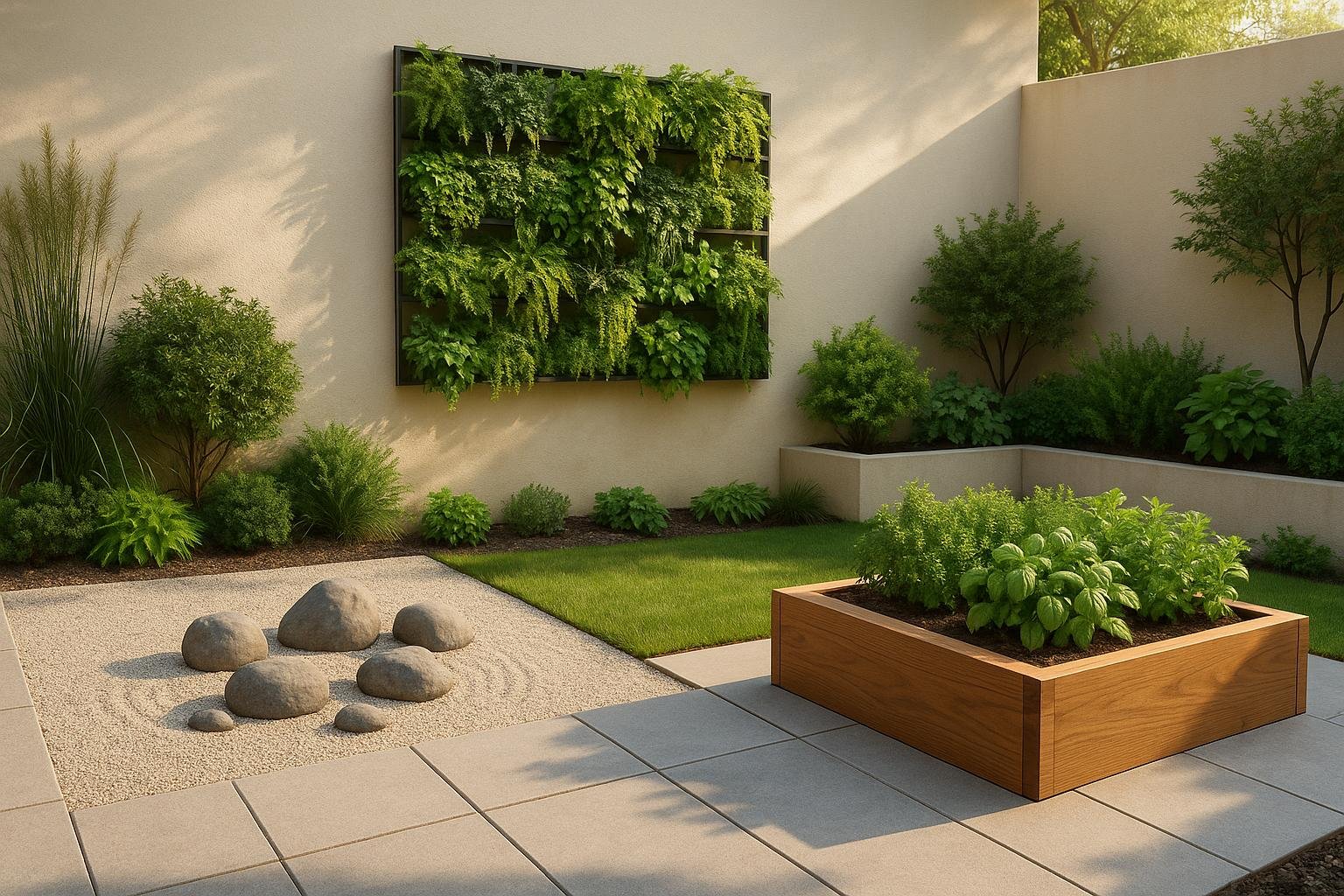
AI garden design tools make landscaping simpler, faster, and more affordable. From modern minimalism to lush edible gardens, these tools analyze your space, climate, and preferences to create tailored designs in seconds. Here’s a summary of the seven styles you can explore:
- Modern Garden: Clean lines, geometric layouts, and low-maintenance plants. Ideal for urban spaces and contemporary homes.
- Cottage Garden: Overflowing flowers, informal paths, and a cozy, colorful vibe. Perfect for small to medium yards.
- Japanese Zen Garden: Minimalist designs with gravel, rocks, and moss for tranquility. Great for small courtyards or meditation areas.
- Mediterranean Garden: Drought-tolerant plants, terracotta pots, and warm colors. Best for sunny, dry regions.
- Native Plant Garden: Local plants that support wildlife and require minimal care. Works across all U.S. regions.
- Formal Garden: Symmetrical layouts with hedges and topiaries. Ideal for larger properties with a focus on precision.
- Edible Garden: Combines fruits, vegetables, and herbs with landscaping. Great for fresh food and functional beauty.
AI tools like AIGardenPlanner offer personalized designs starting at $15, saving time and money compared to traditional methods. Whether you want a low-maintenance retreat or a vibrant edible landscape, AI makes it easy to create your dream garden.
AI Landscape Design - Get landscaping ideas using just a photo of your yard

Benefits of AI in Garden Style Personalization
AI-powered garden design tools are transforming how homeowners approach landscaping. These tools make it possible to create tailored garden layouts without needing extensive horticultural or design expertise. By analyzing your environment, preferences, and unique constraints, these platforms generate designs that feel like they were crafted by a professional [5].
Here’s how it works: AI uses natural language processing and advanced algorithms to evaluate your garden's specific details. For example, when you upload a photo or describe your space, the system examines factors like local climate, soil type, and sunlight patterns. This deep level of analysis ensures that every plant recommendation and design element aligns perfectly with your garden's conditions. The result? A precise, efficient plan tailored to your needs.
One of the standout advantages of AI garden planners is their speed. What used to take weeks can now be done in minutes. These tools deliver professional-grade designs in as little as 30 to 60 seconds, saving you time and minimizing the risk of costly errors [5][1].
Cost is another major benefit. Platforms like AIGardenPlanner offer high-quality designs starting at just $15, making professional garden planning accessible to nearly any budget. This affordability opens the door for more people to create stunning outdoor spaces without breaking the bank.
AI tools also let you experiment virtually. You can test out different layouts, materials, and plant combinations without committing to any physical changes. By regenerating and comparing multiple design options, you can confidently explore various directions until you land on the perfect plan [3]. This feature reduces the likelihood of expensive mistakes by allowing you to visualize and adjust your garden before making any real-world changes.
AIGardenPlanner, for instance, takes customization to the next level by offering over 50 garden styles that can be tailored to your taste and space. Its AI Plant Advisor provides personalized plant recommendations based on your location, climate, and preferences, ensuring that your garden not only looks good but also thrives in your specific environment.
What sets AI tools apart from traditional gardening guides is their ability to learn and improve over time. These systems continuously refine their recommendations by analyzing user feedback and global gardening data [5]. As a result, their suggestions become more accurate and relevant, adapting to your evolving preferences and environmental changes.
AI garden design also works at any scale. Whether you’re planning a small urban patio or a sprawling backyard, the technology generates detailed layouts tailored to your space. From pathways to plant placements, it offers customized options no matter the size or shape of your garden [3].
Unlike basic design software, AI landscaping tools leverage advanced neural networks trained on extensive garden design data. This allows them to process vast amounts of information and deliver professional-grade results that traditional methods simply can't match [1]. Whether you’re a DIY homeowner or a professional landscaper, these tools provide the accuracy and quality needed for any project.
1. Modern Garden
Modern gardens combine practicality with style, creating sleek, livable outdoor spaces. This approach, which originated during the modernist movement in the early 20th century, has grown into one of the most popular garden styles today [6].
Defining Features
Modern garden design is all about clean lines and simplicity. Unlike traditional gardens that often feature winding paths and lush, dense plantings, modern gardens favor geometric layouts, sharp lines, and a sense of order [7]. The focus is on balancing natural elements with man-made materials.
"In the modern garden style, the plantings take a backseat to the materials and the design of the garden itself." – prettypurpledoor.com [6]
Hardscaping plays a leading role, often overshadowing extensive greenery. Materials like gravel, concrete, and wood are commonly used to create texture and maintain the streamlined look. Typically, one or two materials are repeated throughout the space to ensure a cohesive design [12, 13].
Plants are chosen for their architectural appeal, with succulents and ornamental grasses being popular options. A restrained, often monochromatic color palette is key, and repeating a few plant species throughout the garden enhances the overall impact [12, 13].
Modern gardens also frequently include integrated features such as water elements, built-in seating, and thoughtfully placed outdoor lighting. These additions blur the lines between indoor and outdoor living, making the space feel like an extension of the home [13, 14].
This style is particularly well-suited for urban settings, offering a calm escape from the hustle and bustle of city life. AI tools have made designing modern gardens even easier by streamlining hardscape planning and plant selection.
Best Use Cases
Modern gardens shine in urban settings, where space is often limited. For instance, designer Christina Nielsen transformed a small Brooklyn backyard into a serene sitting area by using stone pavers set in gravel, surrounded by greenery. The result? A peaceful retreat that feels worlds away from the city [8].
These gardens are perfect for homeowners who want a beautiful outdoor space without the hassle of high maintenance. With a focus on hardscaping and carefully selected plants, upkeep is minimal.
"With its simplicity and clean lines, the modern garden can easily become a relaxing and calming retreat." – Marianne Lipanovich, Houzz Contributor [10]
Modern design principles also work wonders in small spaces. By balancing plantings and furniture with paving or decking - generally a 50/50 ratio - you can maximize both functionality and visual appeal. The clean lines and limited color palette help small areas feel more open and organized [9].
For those seeking privacy, modern gardens offer effective solutions. Elements like screens, geometric hedges, and vertical features can divide spaces and block unwanted views, creating a tranquil and secluded atmosphere [9].
Ideal U.S. Climate/Region
Modern gardens adapt well to various U.S. climates, especially as warmer plant hardiness zones have become more prevalent in recent decades [12]. This flexibility makes them a viable option across the country.
Warmer regions like Florida, California, and the Southwest are particularly compatible with modern garden aesthetics. Cities such as Orlando, Miami, and Tampa are top spots for gardening, thanks to their favorable conditions [11]. Additionally, the drought-resistant plants commonly used in modern gardens are perfect for areas with limited rainfall or water restrictions. Incorporating water-efficient practices further reduces the need for irrigation compared to traditional lawns [13].
Urban areas across the U.S. can benefit from this garden style. Its adaptable design principles allow for climate-specific plant choices while maintaining the signature modern look [10].
Maintenance Level
Modern gardens are designed for low to moderate maintenance, largely due to their reliance on hardscaping [6]. With fewer plants to care for, tasks like pruning and replanting are kept to a minimum.
Hardscaping materials like concrete, gravel, and stone require little upkeep beyond occasional cleaning and weed control. The limited plant selection also simplifies care routines, as gardeners can focus on understanding the needs of just a few species.
Sustainability fits naturally with modern garden design. Adding organic matter like mulch or compost improves soil health, while drip irrigation systems and drought-tolerant plants help conserve water [13]. This thoughtful approach makes maintaining a modern garden both manageable and rewarding.
🚀 Ready to Reinvent Your Garden?
Join thousands of homeowners who have transformed their gardens using our AI design tool. Upload one photo to explore endless possibilities.
Get your AI garden designs →2. Cottage Garden
AI tools make it easier than ever to design classic garden styles, like the cottage garden, by helping you choose plants and layouts suited to your local climate. Known for their romantic charm, cottage gardens have evolved from the practical gardens of the late 1400s - once focused on edible and medicinal plants - into the ornamental landscapes we see today [17].
Defining Features
Cottage gardens are loved for their lush, informal look. They feature a mix of flowers, herbs, shrubs, annuals, and even vegetables, all planted closely together [14]. Winding pathways, often made of stone or brick, weave through the space, while white picket fences or natural borders add a cozy touch. The planting style is all about layered blooms that blend naturally, avoiding rigid arrangements [14][15]. Soft, nostalgic colors - like pinks, purples, whites, and blues - set a romantic tone. Plants are often grouped in odd numbers (three, five, or seven) to create visual harmony. Hardscaping elements, such as vintage trellises or stone paths, provide a subtle structure to balance the garden's free-flowing nature. These features make cottage gardens a versatile choice for many residential spaces.
Best Use Cases
Cottage gardens are perfect for creating a lush, colorful look with minimal effort. The dense planting helps suppress weeds and ensures blooms throughout the seasons [16]. They work particularly well in small to medium-sized spaces, where tightly packed perennials, annuals, herbs, and shrubs create a rich, overflowing effect [16]. Combining ornamental plants with culinary ones makes these gardens both beautiful and functional [18]. Their intimate, enclosed feel makes them ideal for peaceful retreats, encouraging relaxation and quiet exploration [18].
Ideal U.S. Climate/Region
Cottage gardens thrive in areas with good rainfall and noticeable seasonal changes. For instance, the Pacific Northwest - west of the Cascade Mountains - offers a climate similar to England, where this style originated [20]. Zones 3–7 are especially suited for traditional cottage garden plants, which benefit from seasonal chill and consistent moisture. However, this style can adapt to other climates with thoughtful plant choices [20][21]. In warmer regions like California, gardeners can achieve the cottage garden vibe with plants that tolerate less water and don’t require winter chill [20]. Similarly, semi-arid areas can embrace the look by using hardy plants such as yarrow and bellflowers [19]. These regional adjustments ensure the garden remains low-maintenance while retaining its charm.
Maintenance Level
Thanks to dense planting and good soil preparation, cottage gardens are relatively easy to maintain. Preparing the soil with compost and organic matter at the start ensures it stays nutrient-rich and well-draining, cutting down on future work [22][23]. The close planting helps conserve moisture and naturally keeps weeds at bay. Routine care includes seasonal pruning to manage overgrowth, mulching in fall or early spring for moisture retention and soil health, and encouraging self-seeding to keep the garden dynamic [23][24]. As Darrell Trout, a passionate gardener and lecturer, puts it:
"A cottage garden has perhaps less regard for rules than for doing what you really love." [22]
This approach to gardening emphasizes personal enjoyment over rigid guidelines, making it as rewarding as it is beautiful.
3. Japanese Zen Garden
Japanese Zen gardens, deeply rooted in ancient traditions, blend timeless design principles with modern adaptability. These serene spaces, also known as karesansui or Japanese rock gardens, originated in Zen Buddhist temples in Kyoto during the Muromachi period (1336–1573). They are designed to inspire tranquility and reflection [25]. With the help of AI, creating these traditional yet personalized landscapes has become quicker and more accessible, offering a minimalist alternative to more elaborate garden styles.
Defining Features
Zen gardens are built around the idea that simplicity can be profoundly impactful. The foundation is typically white gravel or sand, which carries symbolic meanings - purity in Shinto tradition and water or emptiness in Zen philosophy [25]. This gravel is carefully raked into patterns resembling rippling water.
Rocks take center stage in these gardens, often symbolizing mountains, islands, or living beings. Their placement follows specific principles to create balance and harmony. A famous example is Ryōan-ji in Kyoto, where 15 stones are arranged in five distinct groups [25]. The design emphasizes natural flow and encourages quiet contemplation.
Zen gardens are usually compact and enclosed, creating an intimate space for focused viewing [25]. When plants are included, they are typically limited to moss, pruned trees, or low-growing varieties that align with the minimalist aesthetic [27].
As Michel Baridon, a landscape architect, eloquently explains:
"Nature, if you made it expressive by reducing it to its abstract forms, could transmit the most profound thoughts by its simple presence" [25].
Best Use Cases
Zen gardens are perfect for small urban spaces, offering a peaceful retreat in backyards, courtyards, or even indoors with the right lighting. Their compact design makes them ideal for those seeking a low-maintenance escape from the daily grind.
They also serve as excellent transitional spaces, bridging indoor and outdoor areas while maintaining a sense of privacy. Beyond aesthetics, the act of raking sand can be a therapeutic activity, helping to reduce stress and promote mindfulness.
Ideal U.S. Climate/Region
Although Zen gardens originated in Japan’s temperate climate, they can be adapted to various regions across the United States. According to landscape architect Richard Hartlage:
"Japanese-style gardens can be built in any climate, even in the desert" [28].
Regions with temperate climates, such as the Pacific Northwest, Northeast, and parts of the Midwest, are particularly well-suited for Zen gardens, as their conditions closely resemble those of Japan. In hotter areas like the Southwest or Southeast, designers incorporate shade elements, such as carefully placed architectural features or trees [28]. Firms like Studio Arth in the American South use local plant species that thrive in the heat while preserving the essence of a Zen garden [28]. Similarly, Hoerr Schaudt's Kyoto-inspired garden in Portsmouth, Rhode Island, demonstrates how this style can be seamlessly translated to diverse climates [28].
Maintenance Level
Maintaining a Zen garden is simple yet rewarding, often turning into a meditative practice. The primary task is raking the sand or gravel daily or weekly to preserve its clean lines and patterns [29][30]. This process can be both calming and satisfying.
Other maintenance tasks include clearing debris like leaves and twigs to maintain the minimalist appearance [30]. Since Zen gardens feature few plants, upkeep remains manageable year-round. If moss is part of the design, it benefits from light misting during dry spells and some shade from direct sunlight [30]. Trees and shrubs, such as Japanese maples or bamboo, may require occasional pruning to retain their intended shape [30].
Stone and gravel areas might need occasional redistribution or the addition of fresh material to maintain their balance and appearance [30]. Water features, if present, should be cleaned regularly to prevent debris buildup and ensure proper functioning [30].
As garden designer Hugo Torii notes:
"If you want to smile every time you see it, that's okay too. You don't have to meditate there" [26].
This philosophy highlights how even routine upkeep can become a peaceful ritual, enhancing the garden’s purpose as a space for reflection and joy.
4. Mediterranean Garden
Mediterranean gardens bring to life the charm of outdoor living inspired by the landscapes of France, Spain, Italy, Greece, and Morocco. These spaces are all about relaxation, warm colors, and creating inviting areas to enjoy under the sun.
Defining Features
A Mediterranean garden is defined by its shady retreats and natural elegance. Pergolas provide much-needed shade, while curved stone pathways and terracotta pots filled with aromatic herbs add a rustic touch. Water features like fountains not only enhance the visual appeal but also introduce a soothing, tranquil atmosphere. The color palette borrows heavily from nature, featuring hues like cobalt blue, terracotta, mustard yellow, and earthy reddish-browns.
Plant choices are just as thoughtful, focusing on species that thrive in dry, sunny climates. Expect to see silver-leafed plants, lavender, rosemary, and vines that climb gracefully. Olive and cypress trees add vertical interest, while clipped hedges bring structure to the design. Together, these elements create a garden that’s as practical as it is beautiful, perfectly suited for outdoor gatherings.
Best Use Cases
Mediterranean gardens shine as spaces for casual family gatherings or laid-back entertaining. Their low-water design makes them a smart choice for homeowners looking to add beauty without the hassle of constant irrigation. Plus, the inclusion of aromatic herbs like rosemary and thyme doesn’t just enhance the garden’s fragrance - it also elevates any culinary experience.
Ideal U.S. Climate/Region
This garden style thrives in regions with mild, rainy winters and hot, dry summers. In the U.S., California is a standout location, particularly areas like San Diego, which boasts a Mediterranean climate and an extended growing season. A prime example is the city’s 37-acre botanical garden that showcases a variety of garden styles, including Mediterranean designs [31][32]. Other suitable regions include parts of Southern California, the coastal Pacific Northwest, and specific microclimates in Arizona and Texas, provided there’s full sun and well-drained soil [33][34].
Maintenance Level
Mediterranean gardens are a dream for those seeking low-maintenance beauty. Once established, their drought-tolerant plants need minimal watering, and features like gravel pathways and stone walls require little upkeep. Routine care is simple - light pruning and occasional weeding are usually enough.
For those looking to streamline garden care even further, technology can lend a hand. AI tools can analyze soil conditions, create tailored planting plans, and even monitor moisture levels using smart sensors. They can also detect early signs of pests or diseases, making it easier than ever to maintain a healthy, thriving garden [35][36].
With their timeless appeal and easy upkeep, Mediterranean gardens offer a perfect blend of style and practicality.
5. Native Plant Garden
Native plant gardens celebrate the beauty of plants that naturally belong to a specific region. These plants evolved long before human settlement, creating landscapes deeply connected to their environment. This garden style aligns perfectly with today’s push for environmentally friendly landscaping, a movement that’s increasingly supported by AI-driven design tools.
Defining Features
A native plant garden focuses on plants that naturally occur in a particular area and have been part of the local ecosystem for generations. These plants are vital for local wildlife, providing food and shelter for pollinators and other animals. The goal of this garden style is to restore natural ecosystems while maintaining an attractive and organized appearance.
Contrary to the idea that native gardens look wild or untamed, they can be thoughtfully designed with defined shapes, borders, and pathways. Bold-textured plants, statues, or arbors can serve as eye-catching focal points, while mixing plants with different textures adds depth and structure. Planting in sweeping masses or drifts creates a natural flow, mimicking how plants grow in the wild. Beyond aesthetics, these gardens actively combat invasive species and support environmental health. For example, a mature tree in a native garden can absorb more than 48 pounds of carbon dioxide annually[38].
Best Use Cases
Native plant gardens are ideal for homeowners looking to create eco-friendly landscapes. They’re perfect for replacing water-thirsty lawns with wildflower meadows or incorporating regionally appropriate plants into perennial borders. These gardens are also a great choice for those who want to support local wildlife while reducing their environmental impact.
"Incorporating native plants into your landscaping is one of the best decisions you can make for your garden and the environment", says Nick Linden from NationWide Landworks [39].
Additionally, native gardens appeal to those who value preserving their region’s natural heritage and unique landscape character.
Ideal U.S. Climate/Region
Native plant gardens can thrive in every U.S. climate zone because each region has its own variety of indigenous plants. The key is choosing species that match your local conditions, from soil type to sunlight and rainfall.
Here are some region-specific suggestions:
- Northeast: Eastern Red Columbine, Wild Geranium, New England Aster
- Southeast: Coral Honeysuckle, Muhly Grass, Sweet Bay Magnolia
- Midwest: Purple Coneflower, Black-Eyed Susan, Little Bluestem
- Southwest: Desert Marigold, Red Yucca, California Poppy
- Pacific Northwest: Sword Fern, Oregon Grape, Red Flowering Currant
To ensure success, take time to understand your local environment. Visit nearby wilderness areas, public native gardens, or native plant nurseries to learn which plants naturally thrive in your region.
Maintenance Level
Once established, native plant gardens are low-maintenance. These plants require less water than traditional lawns and rarely need fertilizers, as they’re already adapted to local soil. They’re also more resistant to native pests and diseases, reducing the risk of invasive problems.
"Native plants minimize water and fertilizer input after establishment, build habitats, support dynamic relationships with animals, provide erosion control and ground water recharge, and support a strong sense of place", explains Powell Gardens [37].
AI tools can make caring for native gardens even easier. Smart sensors and controllers can adjust watering schedules based on real-time conditions, preventing overwatering. Apps powered by AI can analyze photos to identify pests or diseases early, ensuring timely treatment. These tools also offer personalized maintenance schedules and reminders for essential tasks.
For plant identification, apps like PlantNet and LeafSnap have an accuracy rate of about 87%, making it easier to identify and care for native species in your garden [40].
sbb-itb-4d6a8dd
🎨 Visualize Your Dream Garden Today!
Transform any outdoor space into a professional landscape design in minutes. Just upload a photo, choose your style, and let our AI do the rest.
Start your garden transformation now →6. Formal Garden
Formal gardens are the epitome of order and sophistication in landscape design. These gardens have been around for centuries, showcasing humanity's ability to transform nature into carefully planned, geometric masterpieces. Their origins trace back to ancient civilizations like the Persians and Greeks, and they gained prominence during the Renaissance as symbols of wealth and artistic achievement [41].
Defining Features
At the heart of a formal garden is its commitment to symmetry and precise geometry. Straight pathways and carefully arranged vistas guide the eye through a landscape where every element follows strict design principles. Topiary plays a starring role - shrubs and trees are sculpted into defined shapes, while evergreen hedges maintain a neat and structured look throughout the year [63,64]. Architectural features like fountains, statues, and planters add to the grandeur, with iconic examples like the parterres and fountains at Versailles illustrating this style perfectly [41]. This structured approach aligns seamlessly with modern tools like AI, which can personalize garden designs while preserving their classic symmetry.
Best Use Cases
Formal gardens are ideal for those who value timeless elegance and have the space to accommodate symmetrical layouts. They pair beautifully with traditional architecture and serve as stunning settings for outdoor events. Whether enhancing the curb appeal of a front yard or creating a striking focal point in smaller urban spaces, the structured design of a formal garden adds a sense of refinement and balance to any property.
Ideal U.S. Climate/Region
Formal gardens can flourish in many U.S. climates. Temperate areas (USDA zones 6–8) are particularly suited for the evergreen plants commonly used in these designs, like boxwood and yew. In regions with distinct seasonal changes, such as the Northeast and Mid-Atlantic, the garden's architectural features remain visually striking even when deciduous plants go dormant in winter. In Mediterranean climates, like those in California and parts of the Southwest, drought-resistant plants can replace traditional evergreens without sacrificing the garden’s structured charm. Tools like AIGardenPlanner make it easier than ever to adapt formal garden designs to different climates by recommending plants that thrive locally while maintaining the garden's classic geometry [42].
Maintenance Level
Keeping a formal garden in pristine condition requires a high level of care. Clean lines, symmetry, and geometric precision depend on regular maintenance. Tasks like trimming topiary and hedges demand attention to detail, as even small inconsistencies can disrupt the garden's balance. Fortunately, modern technology can help simplify upkeep. Smart sensors can monitor soil moisture and adjust irrigation, while image recognition systems can identify early signs of pests or diseases. AI-powered apps can provide tailored maintenance schedules and reminders, and advanced tools can analyze soil samples to determine the best fertilization practices [36]. These innovations make it easier to maintain the polished look of a formal garden, making them an appealing choice for homeowners in a variety of climates.
7. Edible Garden
Edible gardens bring together aesthetics and practicality by combining food production with attractive landscaping. Unlike the typical vegetable patch that’s tucked away, these gardens seamlessly integrate fruits, vegetables, and other edibles into decorative outdoor spaces. Gardening expert Brie Arthur sums it up perfectly:
"The term foodscaping, by Brie's interpretation, simply means the incorporation of edibles into a traditional ornamental landscape" [44].
Defining Features
What sets edible gardens apart is their ability to blend beauty with function. These gardens incorporate a variety of plants - vegetables, fruits, nuts, edible flowers, and even medicinal herbs - into landscapes that can fit anywhere: front yards, patios, rooftops, or even narrow alleyways [43][45]. Many designs rely on perennials or hardy shrubs that provide annual yields with little upkeep [45].
In the U.S., many homes have enough outdoor space to embrace edible gardening. This approach not only enhances the visual appeal of a yard but also reduces the miles food travels to reach your plate. For context, supermarket produce often journeys 1,500 to 2,500 miles before it lands in stores [44]. This makes edible gardens a practical choice, especially in urban and suburban areas where space is limited, and local food production is a priority.
Best Use Cases
Edible gardens shine when space is tight, but the desire for fresh, homegrown food is strong. They allow homeowners to grow their own produce without sacrificing the charm of their outdoor space. These gardens are also great for families who want to learn more about food production while enjoying a visually appealing yard. Urban and suburban homes, in particular, can benefit from edible landscaping, as it maximizes productivity in smaller plots while also supporting pollinators with diverse plantings.
Ideal U.S. Climate/Region
Edible gardens thrive in a variety of U.S. climates, each offering unique advantages for growing fresh produce. For instance:
- California’s Mediterranean climate supports a wide range of crops and allows for year-round harvests [47].
- Florida’s humid subtropics are perfect for tropical and subtropical fruits like citrus, avocados, and tomatoes [47].
- Texas and the Deep South enjoy extended growing seasons, enabling nearly continuous cultivation [46].
- North Carolina offers fertile soil and a humid subtropical climate, ideal for sweet potatoes and blueberries [46][47].
- Oregon’s temperate maritime climate, with its rich volcanic soil, is fantastic for berries and tree fruits [46].
To make the most of your edible garden, aim for 6–8 hours of sunlight daily and test your soil for pH and nutrients [46]. Knowing your region’s frost dates will help you plan your planting schedule, while tools like cold frames and row covers can extend the growing season and protect plants from unexpected weather changes [47].
Maintenance Level
Edible gardens require consistent care, blending the upkeep of ornamental plants with the demands of food production. Tasks like watering, fertilizing, pest control, and harvesting are ongoing throughout the growing season. However, modern tools have made managing these gardens much easier.
AI-powered technologies are transforming garden maintenance. Tools like smart sensors and AI controllers can adjust watering schedules in real time, ensuring plants aren’t overwatered or left thirsty [36]. AI systems can also analyze plant photos to detect pests or diseases early, allowing for quick action before issues escalate [36]. Soil analysis tools powered by AI identify nutrient deficiencies and recommend the exact fertilizers needed [36]. Even better, AI can predict harvest times, helping with meal planning and food preservation [36].
For added convenience, virtual gardening assistants provide reminders for key tasks like watering and fertilizing. Some advanced systems even automate chores like weeding and help you create efficient planting schedules [48]. Platforms like AIGardenPlanner take it a step further, offering tailored plant recommendations based on your location and climate, along with detailed guides to ensure success throughout the season. These innovations make edible gardening more accessible and enjoyable than ever.
Garden Style Comparison Table
Compare seven distinct garden styles side by side to identify the best match for your space. This table highlights each style's key features, helping you decide based on your needs, climate, and how much upkeep you're ready to commit to.
| Garden Style | Key Features | Best Use Cases | Ideal U.S. Climate Regions | Maintenance Level |
|---|---|---|---|---|
| Modern Garden | Clean lines, geometric shapes, minimalist plants, architectural elements, neutral tones | Small urban spaces, contemporary homes, low-maintenance landscapes | Zones 6–10; thrives in moderate to warm climates with steady temperatures | Low-moderate: Occasional pruning and seasonal care |
| Cottage Garden | Dense plantings, mixed flowers and vegetables, informal pathways, climbing plants | Rural properties, traditional homes, family gardens, spaces for cutting flowers | Zones 4–8; best in temperate climates with good rainfall and mild summers | High: Regular watering, deadheading, and replanting |
| Japanese Zen Garden | Asymmetrical design, natural materials (stone, bamboo), water features, evergreen plants | Meditation areas, small courtyards, stress-relief spaces, minimalist landscapes | Zones 5–9; works well in areas with distinct seasons | Moderate: Pruning, raking, and maintaining clean lines |
| Mediterranean Garden | Drought-tolerant plants, gravel paths, terracotta pots, herbs, silver-leafed plants | Dry climates, water-wise gardens, sunny slopes, coastal areas | Zones 8–11; ideal for warm, dry regions with mild winters and hot summers | Low: Minimal watering once plants are established, occasional pruning |
| Native Plant Garden | Indigenous species, wildlife habitat, seasonal interest, natural look | Wildlife conservation, sustainable landscapes, erosion control, naturalized areas | All zones; plant selection depends on your region but works nationwide | Low-moderate: Minimal care after establishment, seasonal cleanup |
| Formal Garden | Symmetrical layouts, clipped hedges, geometric beds, structured pathways | Large properties, estate gardens, ceremonial spaces, traditional architecture | Zones 5–9; thrives in climates that support consistent hedge growth | High: Precise trimming, edge maintenance, and detailed plant care |
| Edible Garden | Food-producing plants, attractive vegetables, fruit trees, herb spirals | Urban homesteads, family properties, fresh food production, sustainable living | Zones 3–11; crop choices vary by region, with southern zones allowing year-round growth | Moderate-high: Regular watering, fertilizing, pest control, and harvesting |
USDA Hardiness Zones are a helpful guide for plant selection. Zones 3–5 cover colder areas, 6–8 include much of the continental U.S., and 9–11 suit warmer or coastal regions [49][50].
This table gives a quick snapshot of which style fits your space and lifestyle. Beyond choosing a style, modern tools can simplify the process. Advanced AI systems can monitor plant health, suggest climate-specific plants, and even help plan maintenance schedules [4]. These tools make it easier for both professionals and homeowners to create low-maintenance, thriving gardens [4].
When deciding on a garden style, think about more than just looks. Factor in your local climate, how much time you can dedicate to upkeep, and how you plan to use the space. Tools like AIGardenPlanner can help you visualize these styles in your yard and provide tailored plant suggestions based on your climate.
How AIGardenPlanner Improves Style Customization
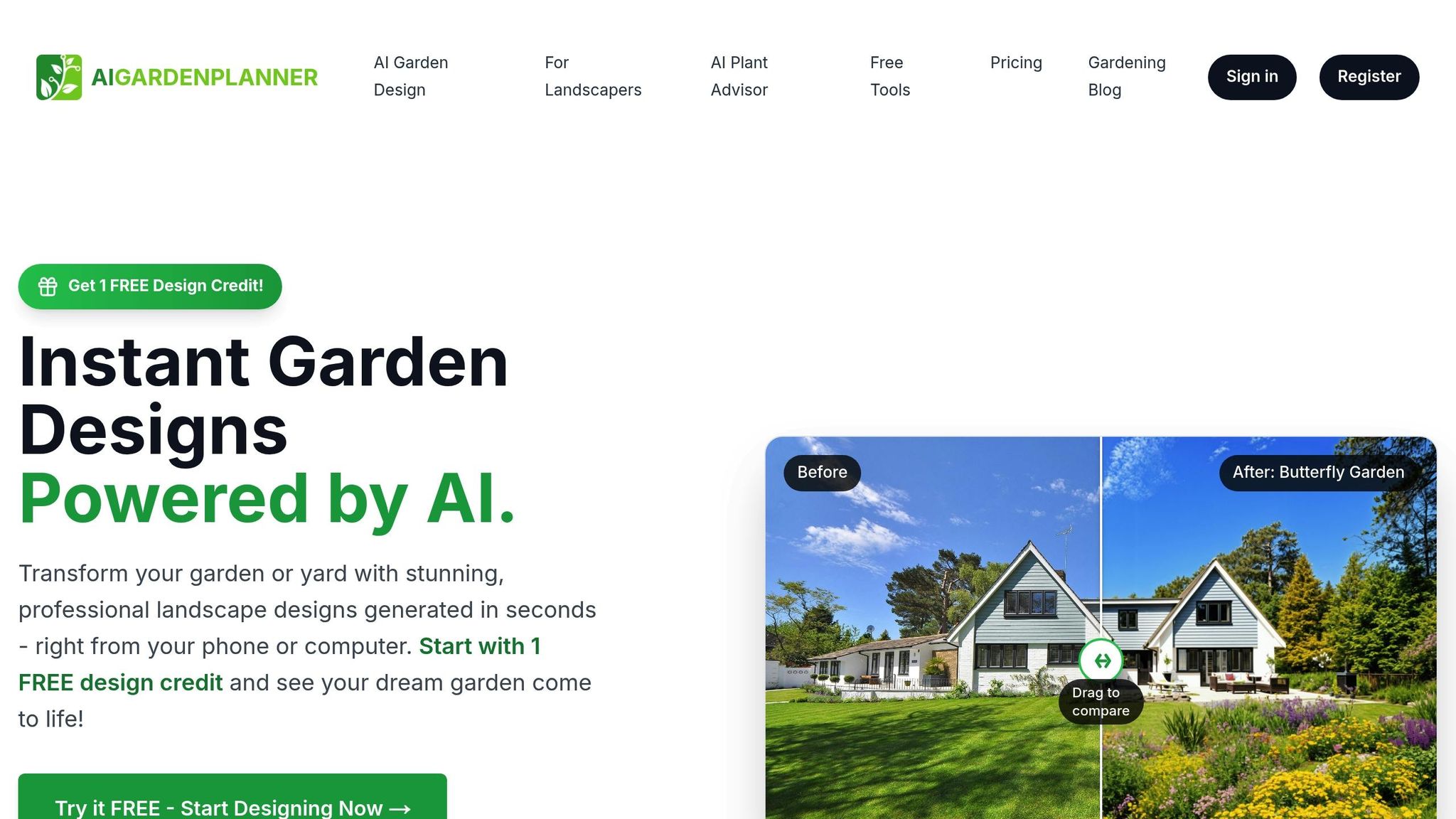
AIGardenPlanner takes the guesswork out of garden design by using AI to deliver tailored recommendations based on your outdoor space and local climate. It simplifies what can often be a complex process.
It all starts with a photo upload of your garden or yard. From there, the AI analyzes your current layout and reimagines it using professional design principles. You can pick from over 50 pre-designed garden styles - ranging from sleek modern layouts to cozy cottage vibes - or mix and match elements to create a custom look that reflects your taste [2].
The platform’s AI Plant Advisor goes a step further by factoring in your location, climate, soil type, sunlight exposure, water availability, and upkeep preferences. For instance, a Mediterranean-style garden in Arizona will feature plants suited for desert conditions, while the same style in North Carolina will include a completely different selection. This level of precision ensures that your garden design isn’t just beautiful but also practical and sustainable.
AIGardenPlanner doesn’t stop at design. It equips you with step-by-step growing guides, maintenance schedules, and care instructions. These resources cover everything from plant compatibility and spacing to fertilizing, pruning, and pest control [51]. For professional landscapers, the Pro and Premium plans offer time-saving tools like commercial licenses, watermark-free designs, business logo integration, and project management features. These advanced tools can save landscapers over four hours per project, with concepts generated in under a minute [2].
The platform also supports the transition from digital designs to real-life gardens. Features like high-resolution downloads, detailed plant lists, and AI-powered plant identification make it easy to incorporate existing plants into new designs. This ensures your garden not only looks great on paper but thrives in reality.
To get the most out of AIGardenPlanner, provide specific details about your garden, such as dimensions, sunlight patterns, soil type, and how much maintenance you’re willing to do. The more precise your input, the better the recommendations. A single garden plan costs $4.99, and subscription options are available for those who want designs tailored to different seasons [51].
With over 10,000 users worldwide and a 4.5-star rating [2], AIGardenPlanner is a trusted tool for both beginners and seasoned professionals. Its ability to combine personalized recommendations with practical execution makes it a game-changer for anyone looking to create a stunning outdoor space.
🌺 Professional Garden Design in Minutes!
Stop wondering what your garden could look like. Upload a photo and let our AI show you 50+ professional design possibilities instantly.
Transform your garden now →Conclusion
From sleek, modern layouts to the cozy charm of a cottage garden, these seven AI-driven garden styles show just how easy it is to create a flourishing outdoor space.
As we've seen, AI takes the hassle out of garden planning. By analyzing your unique conditions, it delivers tailored designs in minutes. For instance, a 200-square-foot city balcony was transformed with AI's help, utilizing a tiered raised bed system to boost vegetable yields by 40% [53].
With AIGardenPlanner, the process is straightforward: capture, upload, transform. Backed by a 4.6/5 user rating, this tool delivers professional-quality designs that align with your climate, preferences, and style [52]. Whether you're drawn to clean, minimalist lines or lush, cottage-style abundance, AI adapts to your vision effortlessly.
Of course, success hinges on providing precise details - accurate measurements, sunlight patterns, and soil conditions all play a role [53]. And with pricing starting at just $15, professional garden design is now more accessible than ever [52].
Ready to see the transformation? Upload a photo of your garden and let AI turn it into your dream outdoor oasis.
FAQs
How does AI ensure the plants it recommends will thrive in my specific climate and soil conditions?
AI-powered garden design employs advanced algorithms to evaluate factors like local climate - temperature, rainfall, and seasonal trends - and soil properties such as pH levels and texture. By analyzing this data, it recommends plants that are well-suited to your specific environment, increasing their chances of thriving.
This tailored method allows you to design a garden that’s not just visually appealing but also well-suited to your local conditions, making it more resilient and efficient.
What are the benefits of using AI for garden planning instead of traditional methods?
How AI Transforms Garden Planning
AI-powered tools bring a fresh approach to garden planning, offering benefits that go beyond traditional methods. By automating intricate design tasks, these tools save both time and money. They analyze factors like your location, climate, and personal preferences to deliver tailored recommendations, ensuring your garden is not only beautiful but also functional. Plus, with precise layouts and plant suggestions, you can maximize every inch of your space.
One standout feature of AI in garden planning is its ability to generate realistic, high-quality visualizations of your garden before any work begins. This lets you experiment with various styles and layouts, making it easier to refine your ideas and make confident decisions. Whether you're a homeowner dreaming of a backyard oasis or a professional landscaper managing multiple projects, AI simplifies the process and helps bring your vision to life.
Can I use AI tools to explore different garden styles before deciding on a final design?
AI-powered garden design tools offer a simple way to experiment with different garden styles. By uploading photos of your space, these tools generate multiple professional design options, helping you see how various layouts, plants, and features might work before making any decisions.
They also take into account factors like your location, climate, and personal taste, making it easier to create a garden that’s not only visually appealing but also functional for your needs.
Related posts
Related Articles
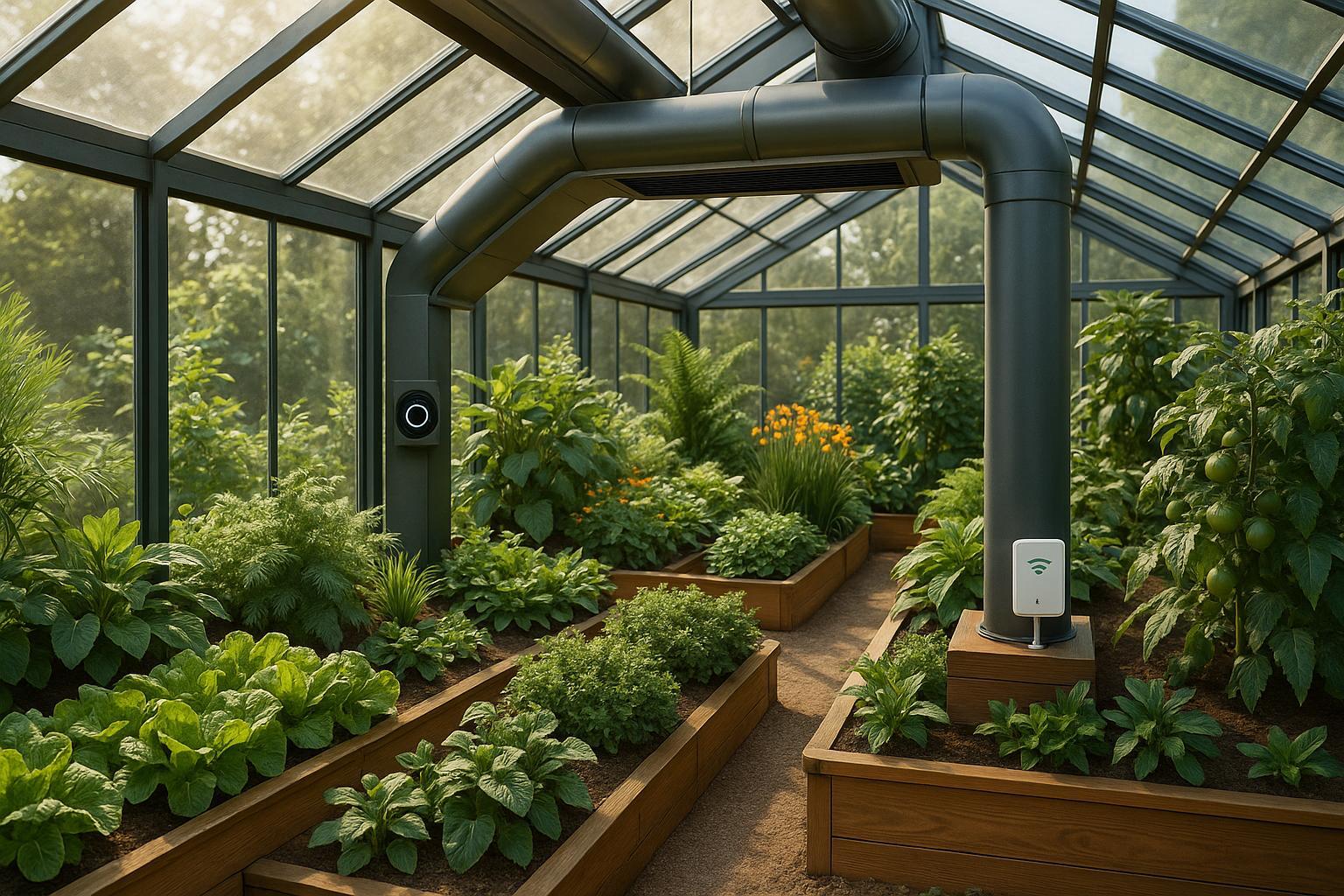
AI-Powered Ventilation for Climate-Specific Gardens
AI-powered ventilation systems optimize garden climates with real-time data and smart technology, enhancing plant health and energy efficiency.
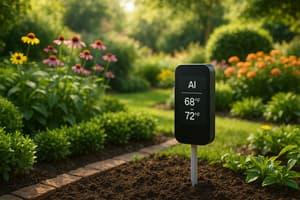
How AI Regulates Garden Temperatures Automatically
AI systems automate garden temperature control, ensuring optimal conditions for plants while conserving energy and resources.
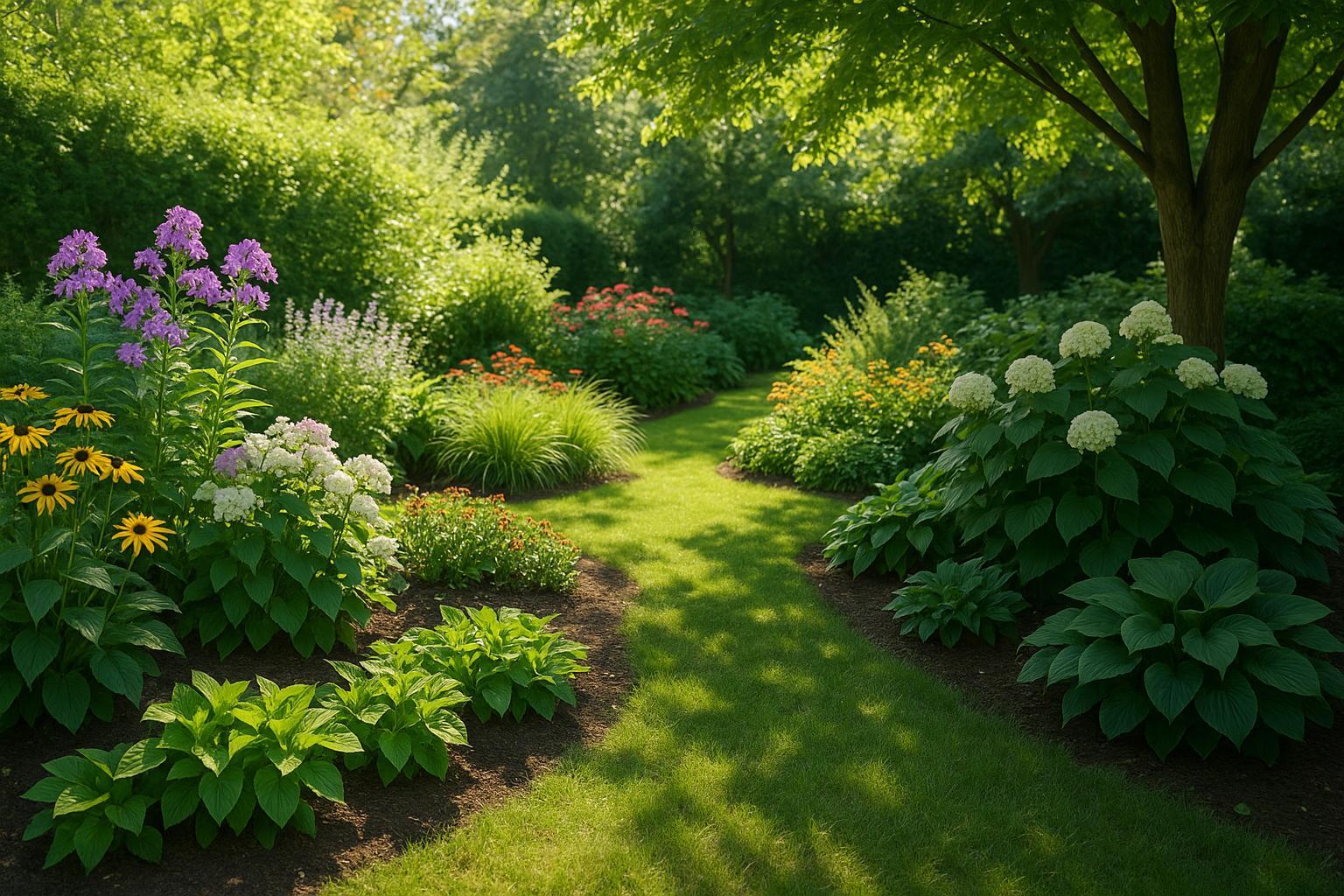
AI Tools for Managing Sun and Shade in Gardens
Explore how AI tools enhance garden management by optimizing sunlight and shade for healthier plants and better yields.
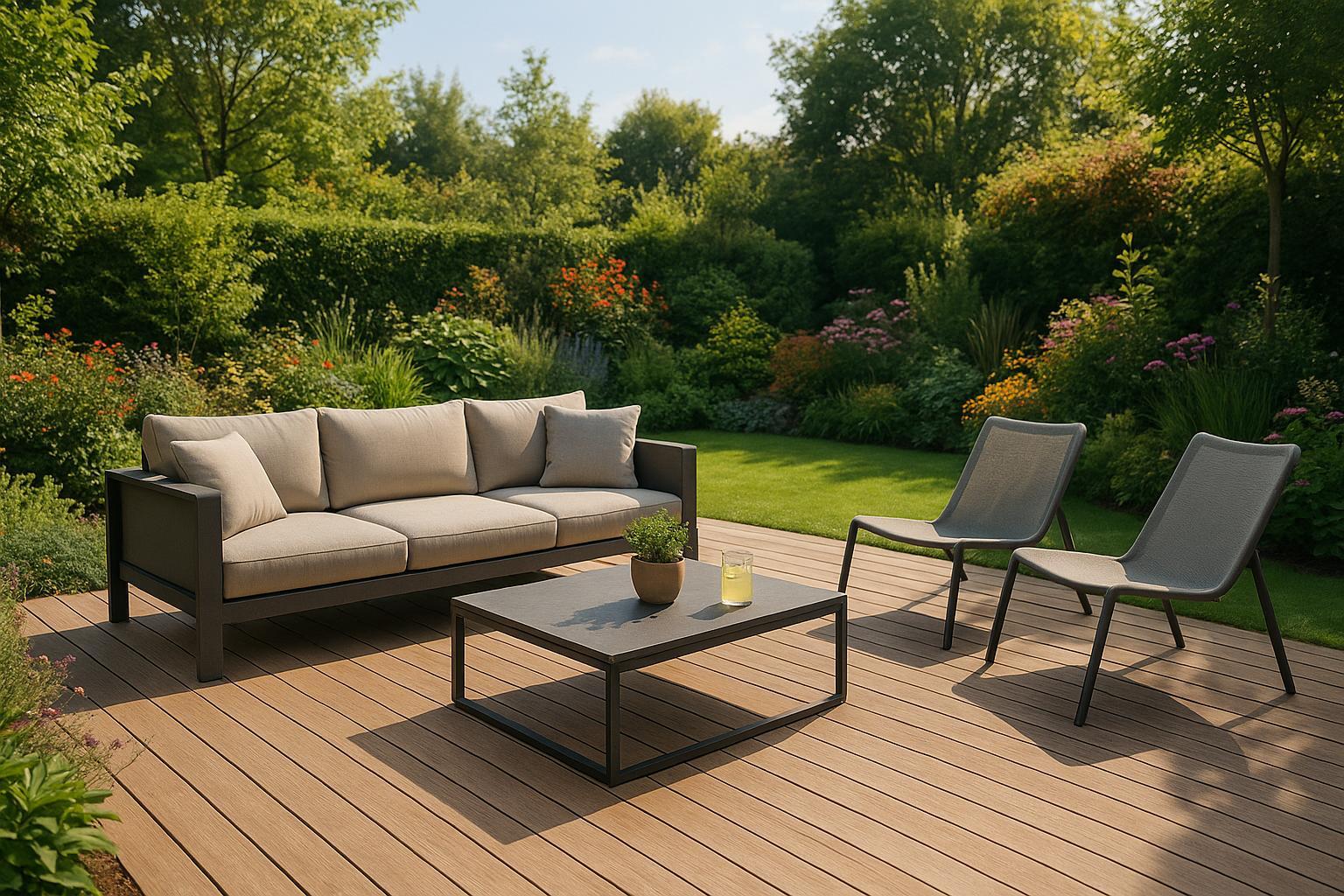
AI-Driven Garden Furniture Placement: How It Works
Transform your garden with AI-driven furniture placement that optimizes style, comfort, and functionality based on your space and preferences.
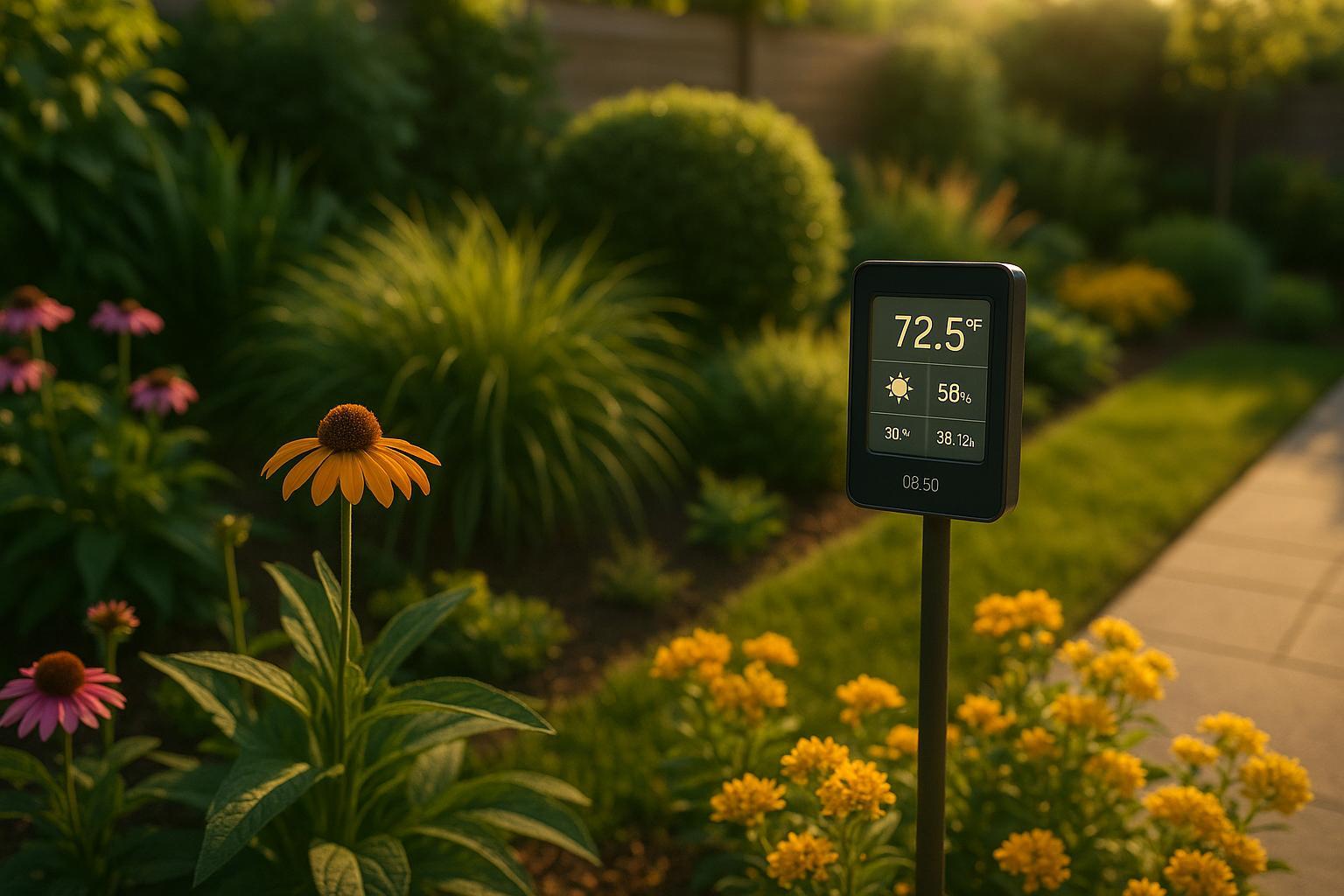
Solving Temperature Fluctuations with AI Tools
Explore how AI tools are revolutionizing garden management by monitoring temperatures, predicting weather, and optimizing plant care for better yields.

AI Tips for Sun and Shade Plant Pairing
Transform your garden with AI tools that simplify sun and shade plant pairing for a thriving mixed-light garden.